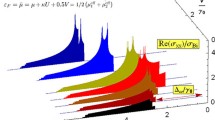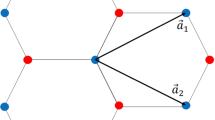Abstract.
We describe the quantum Hall effect (QHE) and far infra-red (FIR) absorption properties of bilayer graphene in a strong magnetic field and contrast them with the weak field regime. This includes a derivation of the effective low energy Hamiltonian for this system and the consequences of this Hamiltonian for the sequencing of the Landau levels in the material: The form of this effective Hamiltonian gives rise to the presence of a level with doubled degeneracy at zero energy. The effect of a potential difference between the layer of a bilayer is also investigated. It is found that there is a density-dependent gap near the K points in the band structure. The consequences of this gap on the QHE are then described. Also, the magneto-absorption spectrum is investigated and an experiment proposed to distinguish between model ground states of the bilayer quantum Hall effect system based on the different absorption characteristics of right-handed and left-handed polarisation of FIR light. Finally, the effects of trigonal warping are taken into account in the absorption picture.
Similar content being viewed by others
References
K.S. Novoselov et al., Proc. Natl. Acad. Sci. USA 102, 10451 (2005); J.S. Bunch et al., Nano Lett. 5, 287 (2005); C. Berger et al., J. Phys. Chem. B 108, 19912 (2004)
J.W. McClure, Phys. Rev. 104, 666 (1956); Y. Zheng, T. Ando, Phys. Rev. B 65, 245420 (2002); V.P. Gusynin, S.G. Sharapov, Phys. Rev. Lett. 95, 146801 (2005); A.H. Castro Neto, F. Guinea, N.M.R. Peres, Phys. Rev. B 73, 205408 (2006); N.M.R. Peres, F. Guinea, A.H. Castro Neto, Phys. Rev. B 73, 125411 (2006)
E. McCann, D.S.L. Abergel (Springer-Verlag, 2007)
E. McCann, V.I. Fal'ko, Phys. Rev. Lett. 96, 086805 (2006)
K.S. Novoselov et al., Science 306, 666 (2004)
K.S. Novoselov et al., Nature 438, 197 (2005)
K.S. Novoselov et al., Nat. Phys. 2, 177 (2006)
Y. Zhang, J.P. Small, M.E.S. Amori, P. Kim, Phys. Rev. Lett. 94, 176803 (2005); Nature 438, 201 (2005)
K.S. Novoselov, E. McCann, S.V. Morozov, V.I. Fal'ko, M.I. Katsnelson, U. Zeitler, D. Jiang, F. Schedin, A.K. Geim, Nat. Phys. 2, 177 (2006)
E. McCann, Phys. Rev. B 74, 161403 (2006)
D.S.L. Abergel, V.I. Fal'ko, cond-mat/0610673 (2006)
R.E. Prange, S.M. Girvin, The Quantum Hall Effect (Springer-Verlag, New York, 1986)
M.L. Sadowski, G. Martinez, M. Potemski, C. Berger, W.A. de Heer, Phys. Rev. Lett. 97, 266405 (2006)
C.L. Lu, C.P. Chang, Y.C. Huang, R.B. Chen, M.L. Lin, Phys. Rev. B 73, 144427 (2006); J. Nilsson, A.H. Castro Neto, N.M.R. Peres, F. Guinea, Phys. Rev. B 73, 214418 (2006); M. Koshino, T. Ando, Phys. Rev. B 73, 245403 (2006); F. Guinea, A.H. Castro Neto, N. Peres, Phys. Rev. B 73, 245426 (2006); B. Partoens, F. Peeters, Phys. Rev. B 74, 075404 (2006); S. Latil, L. Henrard, Phys. Rev. Lett. 97, 036803 (2006)
F. Léonard, J. Tersoff, Appl. Phys. Lett. 81, 4835 (2002)
K.W.K. Shung, Phys. Rev. B 34, 979 (1986); E.A. Taft, H.R. Philipp, Phys. Rev. 138, A197 (1965)
T. Ohta, A. Bostwick, T. Seyller, K. Horn, E. Rotenberg, Science 313, 951 (2006)
M.S. Dresselhaus, G. Dresselhaus, Adv. Phys. 51, 1 (2002); R.C. Tatar, S. Rabii, Phys. Rev. B 25, 4126 (1982); J.-C. Charlier, X. Gonze, J.-P. Michenaud, Phys. Rev. B 43, 4579 (1991); We use \(\gamma _{1}=0.39\,{\rm eV}, c_0 = 3.35\,{\rm \AA}, \varepsilon_r = 1\) and v=8.0×105ms-1 bib:Novo05
G. Dresselhaus, Phys. Rev. B 10, 3602 (1974); K. Nakao, J. Phys. Soc. Jpn. 40, 761 (1976); M. Inoue, J. Phys. Soc. Jpn. 17, 808 (1962); O.P. Gupta, P.R. Wallace, Phys. Stat. Sol. B 54, 53 (1972)
E.V. Castro et al., cond-mat/0611342
The true value of the gap between the conduction and valence band, occuring at p ≠0, is \(\tilde{{\rm \Delta}} = |{\rm \Delta} |\gamma_1 / (\gamma_1^2 + {\rm \Delta}^2)^{1/2} \). For huge asymmetry |Δ | ≫γ1, the gap saturates at \(\tilde{{\rm \Delta}} \approx \gamma_1\) although for modest asymmetry |Δ | ≪γ1, as considered throughout this paper, we have \(\tilde{{\rm \Delta}} \approx |{\rm \Delta} |\)
Author information
Authors and Affiliations
Rights and permissions
About this article
Cite this article
Abergel, D., McCann, E. & Fal'ko, V. QHE and far infra-red properties of bilayer graphene in a strong magnetic field. Eur. Phys. J. Spec. Top. 148, 105–115 (2007). https://doi.org/10.1140/epjst/e2007-00230-8
Issue Date:
DOI: https://doi.org/10.1140/epjst/e2007-00230-8




